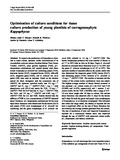Impact of AMPEP on the growth and occurrence of epiphytic Neosiphonia infestation on two varieties of commercially cultivated Kappaphycus alvarezii grown at different depths in the Philippines
- Global styles
- MLA
- Vancouver
- Elsevier - Harvard
- APA
- Help

View/
Date
2011Author
Page views
4,645ASFA keyword
AGROVOC keyword
Taxonomic term
Metadata
Show full item record
Share
Abstract
Two varieties of the carrageenophyte Kappaphycus alvarezii (Tungawan, TUNG; and Giant tambalang, GTAM) from Zamboanga Sibugay, Philippines were used to test the efficacy of Acadian Marine Plant Extract Powder (AMPEP) as source of nutrients for growth, and to determine if applications had any effect on the percent occurrence of an epiphytic infestation of the red alga Neosiphonia sp. at four different depths in the sea. Results showed that the use of AMPEP significantly (P < 0.05) increased the growth rate of both Kappaphycus varieties tested but decreased the percent occurrence of Neosiphonia sp. The percent occurrence of Neosiphonia sp. infection (6–50% at all depths) of both Kappaphycus varieties with AMPEP treatment was significantly lower than the controls (i.e., 10–75% at all depths). Both the growth rate of the cultivated seaweed and the percent occurrence of the epiphytes decreased as the cultivation depth increased. Plants dipped in AMPEP and suspended at the surface had the highest growth rates (i.e., 4.1%, TUNG; 3.1%, GTAM) after 45 days; those without AMPEP dipping had the highest percent occurrence of Neosiphonia infection (viz. 70–75%). The occurrence of Neosiphonia infestation was found to be correlated with changes in irradiance and salinity at the depths observed. The results suggested that both varieties of K. alvarezii used in this study have the fastest growth rate when grown immediately at the water surface. However, in order to minimize damage caused by the occurrence of epiphytic Neosiphonia, K. alvarezii should be grown within a depth range of 50–100 cm. These observations are important for the improved management of Kappaphycus for commercial farming. Furthermore, the use of AMPEP treatments for enhancement of growth and reduction deleterious Neosiphonia sp. infections is encouraging.
Description
From the issue entitled "Special Issue: Twentieth International Seaweed Symposium".
Suggested Citation
Borlongan, I. A. G., Tibubos, K. R., Yunque, D. A. T., Hurtado, A. Q., & Critchley, A. T. (2011). Impact of AMPEP on the growth and occurrence of epiphytic Neosiphonia infestation on two varieties of commercially cultivated Kappaphycus alvarezii grown at different depths in the Philippines. Journal of Applied Phycology , 23(3), 615-621. https://doi.org/10.1007/s10811-010-9649-9
Type
ArticleISSN
0921-8971Collections
- Journal Articles [1258]
Related items
Showing items related by title, author, creator and subject.
-
Growing the reproductive cells (carpospores) of the seaweed, Kappaphycus striatum, in the laboratory until outplanting in the field and maturation to tetrasporophyte
Luhan, Maria Rovilla J.; Sollesta, Hananiah (Springer Verlag, 2010)Carposporophytes of the seaweed, Kappaphycus striatum, from the wild were made to shed spores in the laboratory and grown in multi-step culture method until they reached maturity. For each succeeding transfer onto increasingly ... -
Culture technologies for some economically important seaweeds
Ly, Nguyen Xuan (Aquaculture Department, Southeast Asian Fisheries Development Center, 2000) -
Optimization of culture conditions for tissue culture production of young plantlets of carrageenophyte Kappaphycus
Yunque, Dianne Aster T.; Tibubos, Keneth R.; Hurtado, Anicia Q.; Critchley, Alan T. (Springer Verlag, 2011)To improve the production of Kappaphycus plantlets in tissue culture, optimum media concentrations of an Ascophyllum nodosum extract (Acadian Marine Plant Extract Powder, AMPEP), plant growth regulators (PGR), pH–temperature ...





